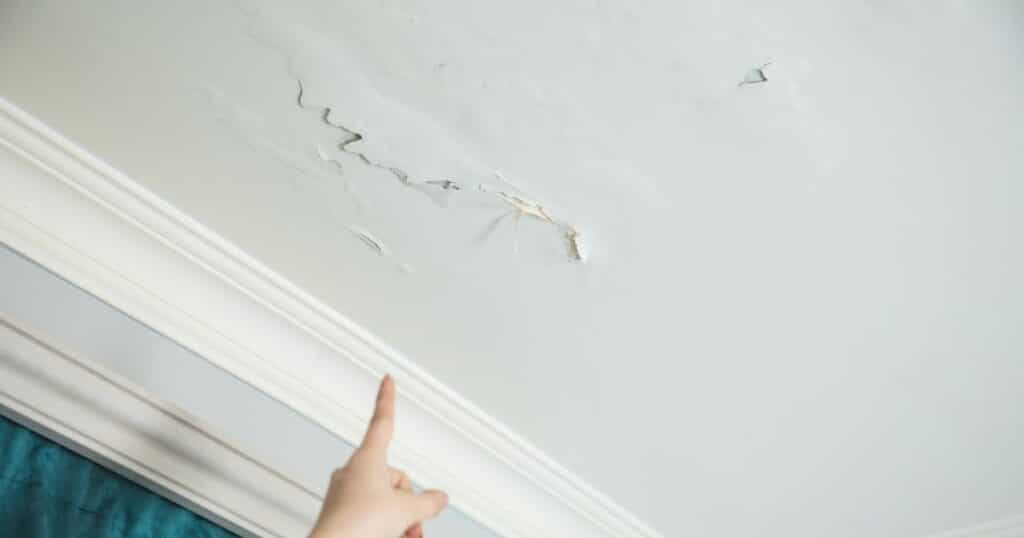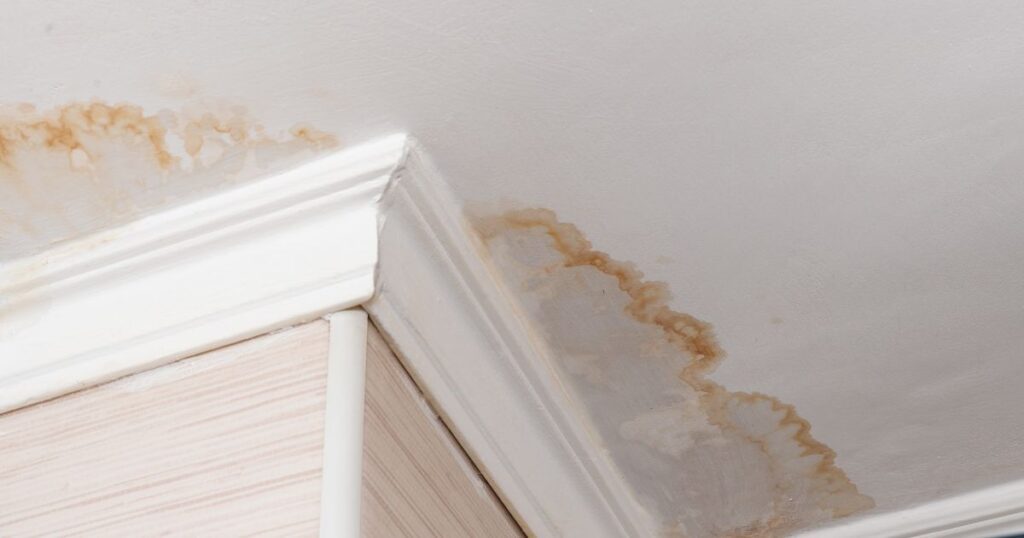
Why Ignoring Drywall Cracks is a Terrible Idea
It’s easy to ignore hairline cracks in your interior walls, but doing so can lead to more significant issues down the line. Drywall cracks are typically an indication that there’s been some structural damage or movement in the wall itself. If you don’t take care of it right away, it can worsen over time and lead to significant repair costs.
If left untreated, a small crack can become larger and affect the entire wall’s integrity. The result may be expensive and time-consuming repairs that could have been prevented by quickly fixing the initial issue at hand.
The Common Causes of Drywall Cracks
Before diving into how to repair drywall cracks, let’s first discuss what causes them in the first place. There are several reasons why your interior walls may crack. One common reason is settling.
As your home ages, the foundation can shift just enough to cause small stress fractures in your interior walls. Another cause is humidity and moisture levels that attract mold or water damage on the surface of your walls, causing them to crumble or rot over time.
Simple wear and tear from daily activities like hanging pictures or moving furniture can create hairline cracks in your drywall. Whatever caused the crack in your wall, it’s imperative to address it sooner rather than later to prevent further damage and potential health issues caused by mold growth.
Fixing Cracked Drywall: DIY vs. Professional Services
Now that you understand why repairing drywall is essential, let’s talk about how you might go about fixing it. You may be wondering whether you should attempt a DIY fix or hire a professional service for this type of task.
While DIY repairs are an option for addressing hairline fractures on smaller surfaces like ceilings or non-load-bearing walls, more extensive damage requires professional assistance. They have the tools and expertise to address any issue – big or small.
If you’re not confident in your DIY skills, it’s always wise to call in a professional to handle the job and ensure that your wall is repaired correctly. Plus, with their help, you can avoid costly mistakes that could lead to more significant repair costs down the line.
Assessing the Damage
Inspect the Crack to Determine its Size and Severity
When it comes to drywall cracks, one of the first steps in fixing them is assessing the damage. Inspecting the crack will help you determine how severe it is and what approach you should take to fix it.
Hairline cracks can usually be fixed easily with a simple DIY solution, but larger cracks may require professional help. Grab a flashlight and examine the crack closely.
Is it just a hairline fracture, or has it become wider? Check if part of the drywall has been pushed inwards because this could indicate a structural issue that needs attention from an experienced professional.
Identify Any Underlying Issues that May Have Caused the Crack
Drywall cracks don’t appear out of nowhere. They usually come from some underlying issue that needs addressing first before attempting any repair work.
It could be due to temperature changes, poor installation, humidity issues, settling foundations, or water damage. The causes of drywall cracks vary depending on several factors, including environmental conditions, material quality, and age.
Identifying any underlying issues will ensure that you can fix the root cause before repairing surface damage. To make sure that your repair work lasts long enough, address any other potential problems that can compromise your walls’ integrity while fixing those ugly-looking lines.
Inspecting and identifying are crucial steps in repairing drywall cracks effectively. Once you know what caused them, then only will you be able to repair them confidently without worrying about their recurrence in the future.
Materials Needed
Before we begin to repair drywall cracks, we need to make sure we have the right tools and materials, or else it may become a nightmare. The most basic tools you’ll need are a utility knife, sandpaper (100 grit should work just fine), and a putty knife.
Make sure you also have a high-quality joint compound as well. Additionally, you may need some drywall repair tape, which is essential for larger cracks.
If you’re an experienced DIYer, then you probably already have these tools lying around somewhere in your toolkit. But if not, head on over to your local hardware store and pick them up – trust me, it’s worth it!
Alternatives for Those Who Don’t Have Access to Traditional Tools
Now I know some of us might not be able to go out and purchase all these fancy tools for drywall crack repair. But don’t worry; there are alternatives! For instance, if you don’t have sandpaper handy but do happen to have steel wool lying around – use that instead!
It works wonders on rough edges. In addition, baking soda mixed with water is an excellent alternative to joint compound if that’s what stops you from repairing those stubborn drywall cracks.
You can also use toothpaste or glue mixed with some baking soda for small hairline cracks. If the crack is too big or needs extra reinforcement before applying a joint compound or mesh tape, create your very own patch by cutting out a piece of cardboard that’s slightly bigger than the crack itself and glue it onto the wall before applying any filler material.
No matter what material or tool shortage crisis we’re facing – never fear because there’s always a creative solution! Stay tuned for our next section on preparing the surface before starting your drywall repair project.
Preparing the Surface
Effortless Drywall Crack Repair
Before jumping into repairing your drywall, it’s essential to prepare the surface. No matter how good you are with plaster vs drywall crack repair, if you don’t prepare the surface correctly, your effort might go to waste.
When preparing your damaged wall for repair, you must ensure that there’s no dust or debris left on the surface. Start by removing any loose bits of plaster or drywall and vacuuming up all dust particles.
Drywall Crack Repair Tips
Once you have removed any debris from the area that needs repair, it’s time to sand down rough edges using medium-grit sandpaper. Sanding will help create a smooth surface for joint compound and tape adhesion. After sanding, wipe down the wall with a damp cloth and let it air-dry completely before you start repairing.
Tools for Drywall Repair
Having the right tools for mastering drywall repair is key to achieving professional results. Make sure you have all necessary materials like gloves, protective eyewear, joint compound for drywall repair, drywall crack repair tape or mesh tape, putty knife or trowel, as well as sandpaper of different grits. Preparing your damaged wall before fixing cracked drywall is crucial in achieving professional drywall patching results.
Ensure that you take time to assess the cracks and determine their size before starting repairs. Remember that effort spent preparing your damaged wall will pay off in creating a smooth surface for adhesion leading to effortless drywall crack repair.
Repairing Small Cracks
Revive Your Cracked Drywall with Toothpaste or Baking Soda
Drywall cracks are a common occurrence that can make your home look unappealing and unfinished. Hairline cracks are especially annoying because they’re difficult to repair without hiring a professional. But what if I told you that you could revive your cracked drywall with toothpaste or baking soda?
Yes, you heard me right! These common household items can be used as a quick fix for minor hairline cracks in drywall.
- To use toothpaste, simply squeeze a small amount onto your fingertip and apply it to the crack. Use a putty knife to smooth it out and let it dry overnight. In the morning, sand down any excess and paint over the area using color-matching paint.
- If you’re more of a baking soda fan, then mix it with enough water to create a paste-like consistency. Apply it over the crack using a putty knife and let it dry completely before lightly sanding down any excess. Paint over the area using color-matching paint.
Drywall Repair Tape is Not Always Necessary
Repairing small cracks in drywall can be done quickly and easily without the need for expensive tools or materials like drywall repair tape. The trick is to apply joint compound directly into the crack using your finger or putty knife, smoothing it out until it’s flush with the surrounding wall surface.
You might be thinking that this sounds too easy to work effectively, but trust me, it does! Not only will this method save you time and money on unnecessary materials like tape, but it also produces less waste than traditional methods.
Prevention of Drywall Cracks
Prevention is always better than cure! While there are many ways to fix drywall cracks once they occur, preventing them in the first place is always the best option. Here are some preventative measures that you can take to ensure that your drywall remains intact:
- Use a humidifier to maintain a consistent humidity level in your home
- Avoid hanging heavy items from your walls without proper support
- Invest in professional drywall installation and repair services
- Address any underlying structural issues before they become bigger problems
By taking these steps, you can help minimize the chances of encountering stubborn drywall cracks in the future. And remember, when it comes to interior wall crack repair, prevention is key!
Repairing Large Cracks
The Magic of Fixing Drywall Cracks with Joint Compound, Mesh Tape, and Sandpaper
There’s nothing more frustrating than a large crack in your drywall. It’s a glaring eyesore that can ruin the aesthetics of your home.
But don’t fret; it’s not the end of the world. The ultimate guide to repairing drywall cracks involves applying joint compound, mesh tape, and sandpaper to restore your wall to its former glory.
Firstly, using a joint compound is essential when tackling large cracks in drywall. It fills gaps and voids seamlessly, making it an ideal solution for repairing cracks.
Apply a layer of compound over the crack using a putty knife or taping knife until it’s evenly spread across the surface. Next up is mesh tape – this is where things start to get interesting!
Mesh tape strengthens the repair by bridging gaps and preventing future cracking by allowing movement between different sections of drywall. Applying this tape properly will ensure that the joint stays flush with no unsightly bulges or gaps.
Comes sandpaper: this is where you smooth out any rough edges left behind after applying joint compound and mesh tape. The sandpaper will help you achieve an even finish that blends well with adjoining walls.
Effortless Drywall Crack Repair: Tips on How to Blend in New Paint with Existing Paint Colors
While repairing large cracks in drywall may seem daunting enough without considering how to match paint colors, there’s no need to worry! Easy steps to conceal drywall cracks, like blending new paint colors with existing ones on walls, can make all the difference.
Begin by preparing yourself with the necessary tools for drywall repair, such as paintbrushes, rollers, sandpaper, etc. Once you’ve repaired your cracked wall successfully (we suggest following step-by-step instructions), it’s time to blend in new paint with existing paint colors. One option is to add some of the existing wall colors to a small amount of new paint, blending the two colors together until you have an exact match.
Another option is to paint an entire wall – adding a fresh coat of paint can often brighten up a room and may help disguise any discrepancies between old and new colors. There’s no need to panic when faced with repairing large cracks in drywall.
Just follow these simple techniques to mend drywall cracks using joint compound, mesh tape, and sandpaper – then finish off with effortless painting techniques for ultimate smoothness. Revive your cracked drywall and transform your damaged wall into something beautiful!
Preventative Measures
Win Over Stubborn Drywall Cracks
Drywall cracks can be a headache for homeowners, especially those who have had to repair them multiple times. However, there are preventative measures they can take. One such measure is adding reinforcements.
If you’re unsure how to go about this, consult with a professional drywall repair service near you. They will provide guidance on where you can add reinforcement and how best to proceed with the process.
Types of Drywall Cracks and Prevention Tips
There are various causes of drywall cracks, including humidity, temperature fluctuations, and structural issues. To prevent these types of cracks from occurring, consider using flexible caulking in areas prone to movement or shifting, like corners and edges where walls meet the ceiling. Also, be on the lookout for any signs of moisture build-up or water damage, which could lead to further cracking.
DIY Techniques for Preventing Future Cracking
Preventing future drywall cracking doesn’t have to break the bank – in fact, it could save you money in the long run! One technique is applying joint compound for drywall repair before painting your walls.
This will strengthen the integrity of your walls and make them more resistant to cracking over time. Also, consider using mesh tape when patching up larger holes in your wall – this will help keep everything in place while it dries and reduces the chance of future damage.
Overall, taking preventative measures against future drywall cracks doesn’t have to be complicated or expensive – there are plenty of easy steps homeowners can take themselves without having to hire a professional service every time they notice a small crack forming! The key is staying vigilant and taking action as soon as possible so that you don’t have bigger problems down the road!
Frequently Asked Questions
What is the best way to repair cracks in drywall?
The best way to repair cracks in drywall is by using a joint compound, often referred to as mud. Apply this compound over the crack, allow it to dry, then sand it smooth before repainting the repaired area.
How do you fix a crack in a drywall joint?
Fixing a crack in a drywall joint involves first widening the crack slightly with a utility knife, then covering it with a self-adhesive mesh drywall tape, followed by applying several coats of joint compound, allowing each to dry and sanding it smooth before repainting.
How do you keep drywall cracks from coming back?
To keep drywall cracks from coming back, ensure your home’s foundation is secure, and use high-quality materials and professional techniques during drywall installation. Addressing humidity issues in the house and ensuring proper insulation can also help prevent recurring cracks.
Are cracks in drywall serious?
Cracks in drywall can be serious if they indicate a structural issue with the house, such as problems with the foundation or framing. However, small, superficial cracks are common and can occur due to factors like temperature changes and settling over time.
Can you just paint over drywall cracks?
While you can technically paint over drywall cracks, this is only a temporary solution, and the cracks will likely reappear over time. It’s best to properly repair the cracks with joint compound and drywall tape before repainting for a lasting solution.
Conclusion
Key Points from Each Section
Repairing drywall cracks is an essential part of home maintenance. In this article, we have covered the common causes of drywall cracks and how to assess the damage.
We have also explored the tools and materials needed for fixing cracked drywall, as well as creative alternatives for those on a budget. We’ve discussed repairing small and large cracks using easy steps to conceal drywall cracks or ultimate guides to repair drywall cracks.
We’ve looked at joint compounds for drywall repair, mesh tape, sandpaper, and creative solutions like toothpaste or baking soda, depending on the severity of the crack. We’ve suggested preventative measures like adding reinforcements or using flexible caulking to prevent future drywall cracking.
Final Advice on Maintaining a Healthy Home Interior
To wrap up this article about how to repair drywall cracks: transforming your damaged wall into a polished masterpiece should not be hard work if you follow these simple techniques to mend drywall cracks. Drywall crack repair tape may prove useful in some cases. However, it’s important to remember that sometimes it’s better to call in an expert if you’re unsure about tackling significant repairs yourself.
Repairing ceiling drywall crack repair can add up in cost over time if you don’t take preventative measures early on. It pays off in the end when you save money with effortless drywall crack repair instead of having larger problems that require more expensive repairs later down the line.
By following these steps on how to repair drywall cracks without painting or with painting will leave your interior looking refreshed and new while keeping your wallet happy! Remember: fixing cracked drywalls is one thing, but preventing them from happening again is another!






